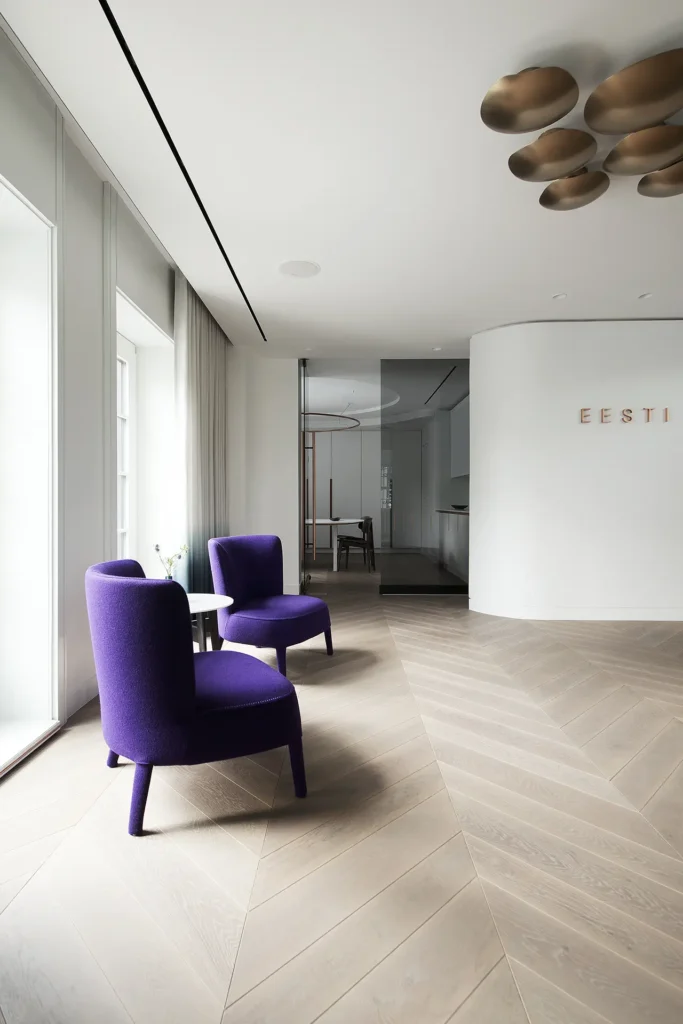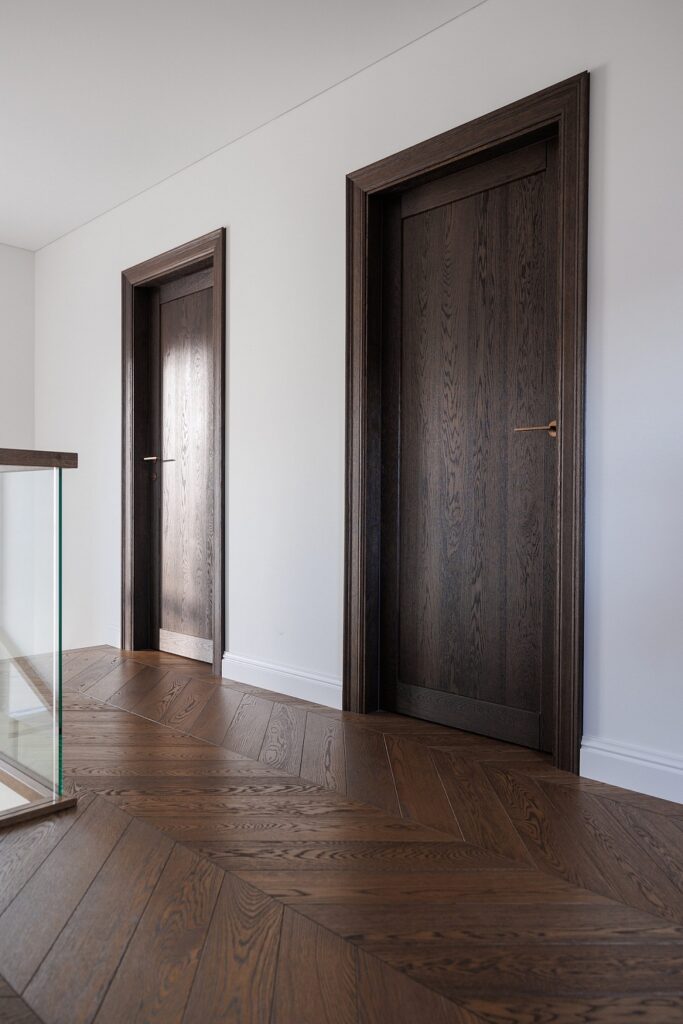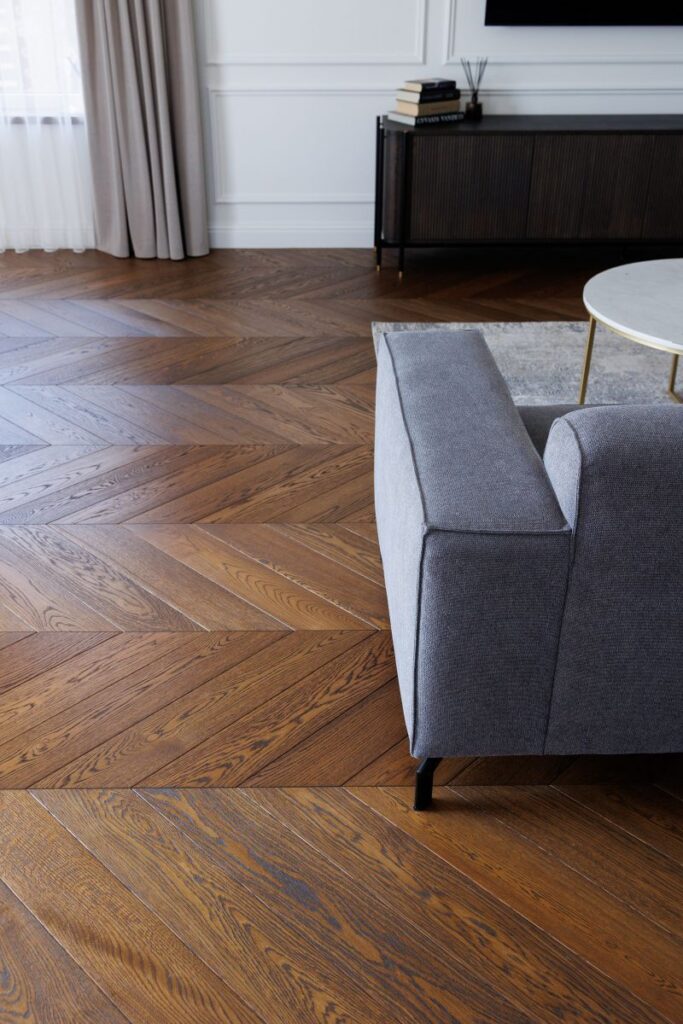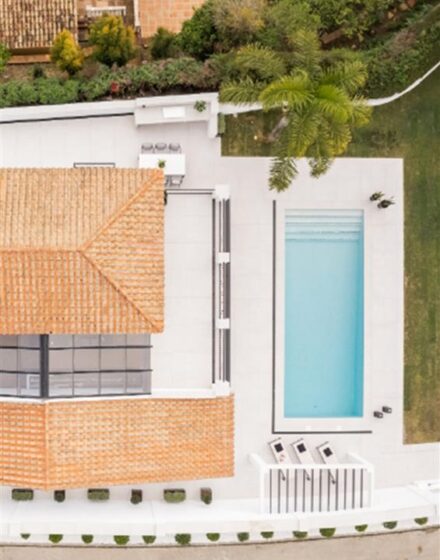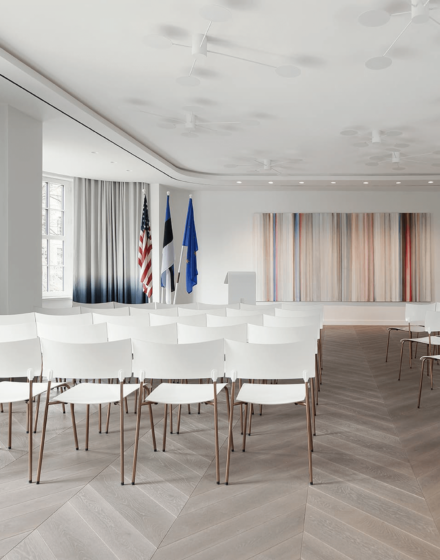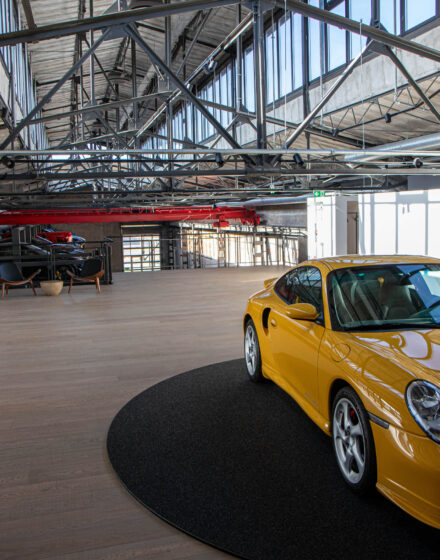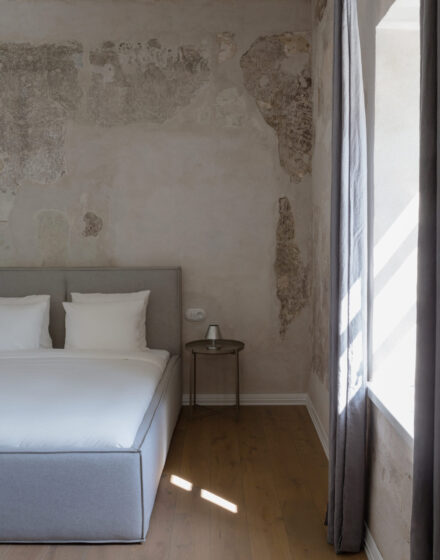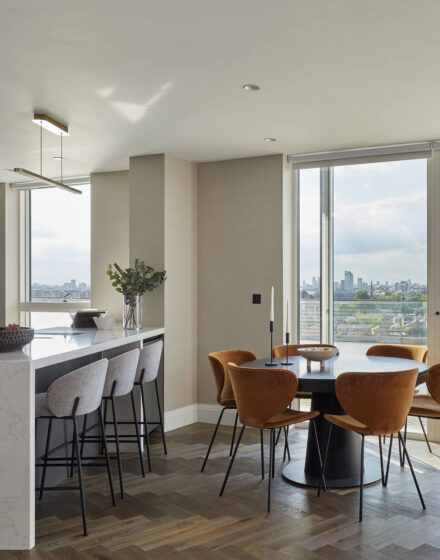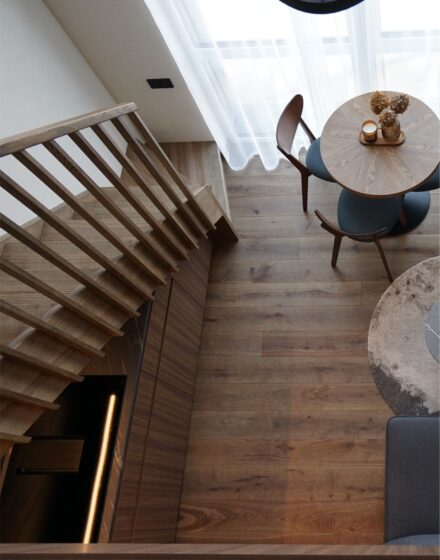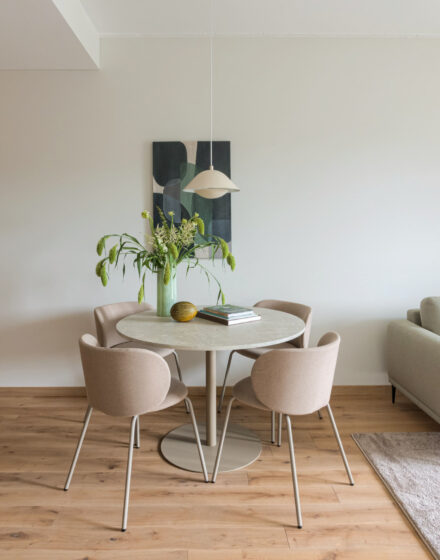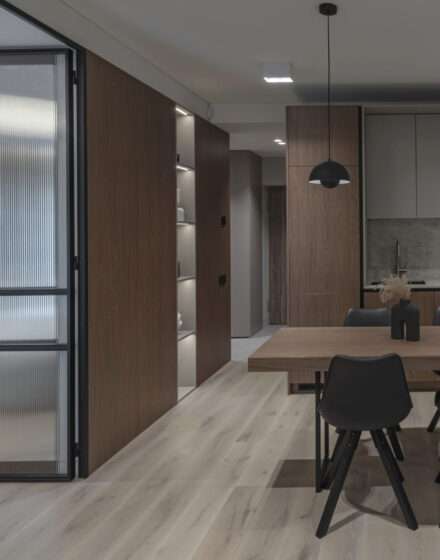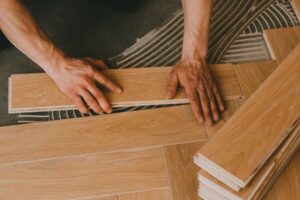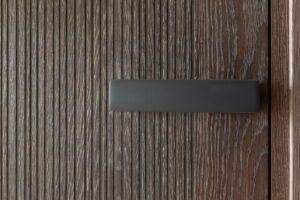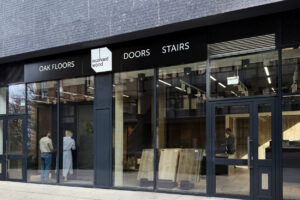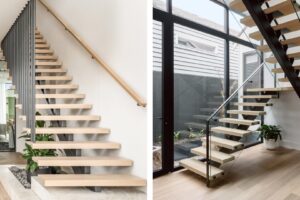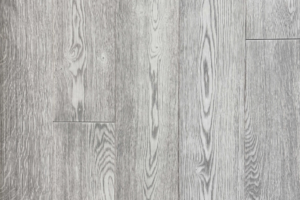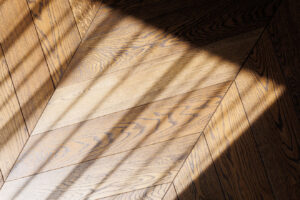From high-end Parisian apartments to Scandinavian-inspired living rooms, chevron flooring is everywhere right now. This iconic pattern, once reserved for grand European interiors, is making a bold return in contemporary design. But why has it captured the attention of architects, interior designers, and style-conscious homeowners across the globe? The answer lies in chevron’s unique ability to combine timeless elegance with modern sophistication—creating spaces that feel both classic and fresh. Let’s explore why chevron oak flooring has become the ultimate statement for today’s interiors.
How chevron flooring elevates different interior styles
Chevron oak flooring isn’t just beautiful—it’s versatile. Here’s how this timeless pattern transforms a variety of interiors:
Scandinavian Serenity
Soft, bright, and beautifully balanced.
Light oak chevron flooring adds warmth and subtle texture to Nordic interiors. It complements clean-lined furniture, white walls, and natural textiles—bringing life to calm, minimalist spaces.
Modern Urban Chic
Luxury that whispers, not shouts.
In contemporary apartments with industrial accents or sleek matte finishes, chevron creates flow and elegance. Choose warm neutral tones like Ivory for understated sophistication.
Contemporary Classic
Timeless elegance with a modern edge.
Pair rich, dark chevron oak with plush fabrics and statement lighting for a bold yet refined atmosphere. This is where modern living meets Parisian charm.
Nature-Inspired Interiors
Bringing the outdoors in—with craftsmanship.
Natural oak chevron fits seamlessly into earthy interiors featuring stone, greenery, and organic textures. The dynamic pattern reflects the lines of nature while elevating the entire space.
See real home installations in our gallery.
A brief history and description of chevron flooring
The history of chevron flooring is rich and dates back centuries, with its origins found in ancient pottery from the Bronze Age and later in medieval heraldry. However, its first appearance as a flooring design emerged in 16th-century Europe, quickly becoming a symbol of luxury and sophistication, particularly in France. The name “Chevron” itself comes from the French word for “rafter,” aptly describing the inverted V-shape of the pattern. While its popularity fluctuated over time, chevron flooring experienced a significant resurgence in recent years, finding its place in both classic and contemporary interior designs due to its timeless elegance and ability to add a sense of movement and visual interest to any space.
Chevron flooring is a distinctive pattern characterized by precisely cut wooden planks laid in a continuous zigzag formation, where the ends of each plank meet at a specific angle to form a sharp point. This creates a visually striking and ordered design across the floor surface. The defining feature of chevrons is the meticulous angular cut at the end of each plank, typically at 30 or 45 degrees, which allows them to fit together seamlessly, creating an unbroken line of chevrons. The exact angles used in chevron patterns are critical to achieving the intended sharp, pointed appearance and the overall aesthetical harmony of the floor. The consistent angle and the precise meeting point of the planks are fundamental characteristics that differentiate chevron from other angled flooring patterns. This precision is not only crucial for the visual impact but also significantly influences the installation process, demanding accuracy to maintain the integrity of the design.
Chevron flooring 30°
 Chevron 45°
Chevron 45°
Herringbone 90°
A crucial point of clarification is the distinction between chevron and herringbone flooring. While both patterns feature angled arrangements of planks creating a zigzag effect, the fundamental difference lies in how the planks are cut and meet. In chevron, as mentioned, the ends of the planks are cut at an angle and are joined to form a continuous point. Conversely, in herringbone, the planks are rectangular and meet at a 90-degree angle, resulting in a broken zigzag pattern where the end of one plank meets the side of another.
Chevron vs. Herringbone – What’s the Difference?
Both chevron and herringbone are classic parquet patterns—but they’re not the same. Here’s how to tell them apart:
- Chevron
Planks are cut at an angle (usually 45° or 30°)
Pieces meet in a continuous V shape, forming a sleek zigzag line
Creates a dynamic, directional flow—perfect for modern spaces
Requires precision craftsmanship for flawless joints - Herringbone
Planks are cut rectangular—no angled ends
Pieces are laid in a staggered, interlocking pattern, like fish bones
Offers a more traditional, textured look
Adds visual interest, especially in classic or rustic interiors
In short: Chevron is sharp, elegant, and modern. Herringbone is timeless, detailed, and cozy.
Explore in more detail: Chevron; Herringbone.
Design and aesthetic aspects of chevron flooring:
The choice of wood species and finish plays a crucial role in the final look of a chevron floor. Light oak with a natural oil finish can create a Scandinavian or minimalist feel, while dark walnut with a glossy polyurethane finish can evoke a more traditional or luxurious ambiance. Exotic hardwoods can add a unique and distinctive touch. The combination of wood species and finish offers a significant degree of customization, allowing designers and homeowners to tailor the flooring to match a wide range of design preferences and interior styles.
The chevron pattern itself significantly contributes to the overall aesthetic of a room; it adds visual interest, texture, and a sense of sophistication that can transform a space. The bold geometric nature of the pattern can serve as a focal point, influencing the selection of other design elements within the room.Chevron floors don’t just look stunning – they also add real value to your space.
Learn more on the projects.
Types and materials of chevron flooring
Chevron flooring is available in a variety of materials, each offering distinct characteristics and benefits.
Solid wood chevron flooring
Made from single hardwood pieces like durable oak with its distinct grain, smooth maple, luxurious dark walnut, or patina-developing cherry, it offers timeless elegance. Product specifications detail available wood species, their unique grain patterns, and hardness levels, which are crucial for both the floor’s aesthetic (color, grain) and functional aspects (durability, maintenance). Hardness directly affects resistance to wear, while grain patterns define the visual texture.
Engineered wood chevron flooring
Engineered chevron oak flooring offers a stable and cost-effective alternative to solid wood, featuring a real hardwood over a plywood. This construction offers several advantages such as resistance to moisture and temperature changes, making it suitable for various environments from hallways and living rooms or bedrooms to kitchens or even bathrooms. While base layer materials and the thickness of the top oak layer may vary, engineered wood features a genuine oak surface. Its layered construction improves dimensional stability, making it less prone to warping. Oak floorboards produced by Ecowood are engineered products. They have great stability when exposed to changes in moisture and temperature.Thanks to the state-of-the-art symmetrical 2 x Oak construction, three-layer floor planks are 15% more energy efficient.
Vinyl flooring
Vinyl Tiles (LVT) or Planks (LVP) are rare in a chevron pattern as it requires special cutting equipment and installation method. Vinyl flooring may offer a durable, water-resistant, and budget-friendly alternative to real wood, making it suitable for moisture-prone areas like kitchens and bathrooms. Planks are easy to maintain and highly resistant to scratches and stains. Manufacturers provide details on wear layer thickness, textures, and installation. Advanced technology allows high-quality vinyl to convincingly mimic wood, offering a cost-effective and durable solution for both homes and businesses, especially in high-traffic or damp environments. It is always the choice between real wood and its mimic in vinyl defined by the needs, preferences and the forward-looking mindset of the buyer.
Laminate flooring
While less common, manufacturers might offer chevron flooring in other materials such as laminate. Laminate flooring typically consists of a high-density fiberboard core with a photographic layer that mimics the appearance of wood, topped with a protective wear layer. If the provided document includes information on such alternative materials, their specific characteristics and benefits would be detailed within.
Manufacturing and specifications
Solid wood chevron flooring involves selecting and milling wood, then precisely cutting planks at a specific angle (usually 30 or 45 degrees) for the zigzag pattern. Engineered wood chevron requires bonding a hardwood to a core before angled cuts. At Ecowood the planks are made using a premium-quality formaldehyde-free adhesive. Vinyl chevron manufacturing includes printing a wood-like design and cutting the vinyl into angled planks. Manufacturing techniques and precision vary, but accurate angle cuts are crucial for proper alignment and a seamless chevron pattern. Tight tolerances ensure the planks meet correctly, which is key to the design.
When selecting chevron flooring, several key specifications should be considered
These include the dimensions of the planks, such as their length, width, and thickness, and the angle of the cut. The type of finish, whether the flooring is prefinished at the factory or left unfinished to be finished on-site, is also important. For engineered chevron oak flooring and vinyl options, the thickness of the wear layer is a significant factor which determines the durability and longevity of the flooring surface. Specific measurements and available options for these specifications for a particular manufacturer’s chevron flooring products would be detailed in their technical documentation. The dimensions of the planks and the cut angle directly influence the visual scale and impact of the chevron pattern within a room: wider or longer planks will generally create a larger, more dramatic pattern, while the angle affects the sharpness and overall appearance of the zigzag. The choice between prefinished and unfinished flooring has implications for the installation process, the overall cost, and the ability to customize the final appearance. Prefinished flooring offers the convenience of quicker installation and consistent factory finishes, while unfinished flooring allows for on-site sanding and staining to achieve a bespoke look.
Installation of chevron flooring
Regardless of the type of chevron flooring being installed, thorough preparation of the subfloor is essential. The subfloor must be clean, level, dry, and structurally sound to provide a stable base for the new flooring. Any imperfections in the subfloor can lead to problems such as unevenness, squeaking, or premature wear. A properly prepared subfloor is fundamental to the stability and longevity of any flooring, and this is particularly true for intricate patterns like chevron.
Installing chevron flooring requires careful planning and layout to ensure symmetry and proper alignment of the pattern. Typically, the process begins by finding the most levelled area of the space and then working forward. Precise measurements and the use of reference lines are critical to maintain the integrity of the zigzag pattern. Precise layout is absolutely essential to achieve the intended visual effect of the chevron pattern. Mistakes made in the initial stages of layout can be challenging and costly to correct later in the installation process. Starting the pattern from the most levelled part of the room and working forward helps ensure a balanced and symmetrical appearance. Our recommendation is to invite professionals who specialize and have experience in installation of sophisticated flooring patterns.
The specific installation methods used for chevron flooring depend on the material
Solid wood chevron is typically nailed down to a wooden subfloor, engineered wood chevron can often be installed using various methods, including nailing, gluing, or a click-lock system, vinyl chevron flooring is commonly installed using glue-down or click-lock methods. Due to the angled cuts and the need for a precise fit, the installation of chevron flooring often requires more skill and attention to detail than simpler flooring patterns. The angled ends of the planks must meet perfectly to form the sharp point of the chevron, which necessitates careful cutting and fitting during installation. This level of precision often requires more time and expertise compared to installing straight planks. Chevron parquet installation guide is helpful but perfection still requires masterful skills of flooring professionals.
If unfinished solid wood chevron flooring is installed, the process includes sanding the floor to a smooth surface, applying the desired stain color, and then finishing with protective coats such as polyurethane.
Maintenance and care of chevron flooring
Regular cleaning practices for Chevron flooring include sweeping or vacuuming (using appropriate attachments to avoid scratching) to remove dust and debris. Damp mopping with a suitable cleaning solution recommended by the flooring manufacturer is also typically advised.
Harsh chemicals or excessive water should be avoided, as they can damage the finish or the material itself. Using the correct cleaning methods and products is crucial for protecting the finish and maintaining the appearance of chevron flooring over time. Different materials and finishes may require specific cleaning agents and techniques.
Taking preventative measures can significantly minimize wear and tear on chevron flooring; these include using rugs in high-traffic areas to protect the surface, placing felt pads under furniture legs to prevent scratches and dents, and controlling humidity levels, especially for solid wood flooring, to prevent warping or gapping. Advice on preventative care specific to their products might be offered by the flooring manufacturer. Protecting the surface from scratches and dents, and managing environmental factors like humidity, helps preserve the flooring’s integrity over time.
Solid wood chevron flooring can typically be refinished multiple times throughout its lifespan to restore its appearance after years of use. This process involves sanding down the existing finish and applying new stain and protective coats.
Benefits of choosing chevron flooring
One of the primary benefits of chevron flooring is its sophisticated and visually striking appearance. The distinctive zigzag pattern is often associated with luxury and classic design, adding a touch of elegance to any space. Chevron flooring has the ability to elevate the overall look of a room, imparting a sense of grandeur and visual interest. The bold geometric pattern creates a dynamic and eye-catching effect that can significantly enhance the interior design.
The pointed V-shaped pattern of chevron flooring can create a sense of direction and flow within a space. Depending on the orientation of the pattern, it can visually lengthen a room or make it feel wider. For example, laying the chevron pattern along the longer dimension of a narrow room can help to elongate the space. While this is a general design principle, manufacturers might offer examples of how the pattern can influence spatial perception in their documentation. The orientation of the chevron pattern is a powerful design tool that can be strategically used to influence the perceived dimensions of a room.
Depending on the material chosen, chevron flooring can offer excellent durability and longevity. Engineered wood and high-quality vinyl options are particularly known for their resistance to wear and tear. Referencing the sections on materials and specifications, along with relevant product details from the manufacturer, can provide specific information on the durability of different Chevron flooring options.
Chevron flooring: Pros, Cons over other patterns
Pros of chevron flooring
- Timeless Elegance
Chevron adds a touch of sophistication and visual interest to any room. Its symmetrical design makes it suitable for both classic and contemporary interiors. - Creates the Illusion of Space
The V-shaped pattern draws the eye along the floor, making rooms appear longer or wider—a great trick for small or narrow spaces. - Boosts Property Value
High-end and designer-like in appearance, Chevron flooring can enhance your home’s aesthetic and market appeal. - Versatility in Design
Chevron works beautifully with wood, vinyl, laminate, or even tile. It also pairs well with a variety of finishes, from natural oak to bold dark stains.
Cons of chevron flooring
- Higher Installation Costs
Because the planks are cut precisely at angles, chevron flooring requires professional installation. This adds to labor costs compared to traditional straight-lay floors. - Material Waste
The angled cuts can lead to more offcuts and waste, increasing overall material requirements and cost. - Complex Repairs
If damage occurs, replacing individual Chevron planks can be more complicated than with standard flooring.
Applications of chevron flooring in various settings:
Chevron flooring is a popular choice for various rooms within a home, including living rooms, dining rooms, hallways, and even bedrooms. Image galleries or case studies provided by flooring manufacturers often showcase examples of their chevron flooring installed in residential settings.
The aesthetic appeal and durability of chevron flooring also make it suitable for commercial environments such as offices, retail stores, restaurants, and hotels. In these settings, it can contribute to a sophisticated and welcoming atmosphere while withstanding higher levels of foot traffic. The adaptability of chevron flooring allows it to seamlessly integrate into a wide spectrum of settings, from the intimacy of residential interiors to the demands of commercial spaces. This versatility stems from the pattern’s inherent elegance and the availability of diverse materials and finishes.
Chevron flooring can complement a variety of interior design styles. It is a classic element in traditional designs, particularly French parquet flooring, but it can also be incorporated into contemporary and even some modern aesthetics, depending on the wood species, finish, and plank size chosen.
Market trends for chevron flooring
Current trends in chevron flooring include the increasing popularity of certain wood species, such as lighter oaks and natural-toned finishes that align with contemporary design preferences. Matte finishes are also gaining traction over high-gloss options. Plank sizes can vary depending on the desired aesthetic, with both wider and narrower planks being used in modern installations. Staying informed about current market trends enables consumers and designers to make choices that are both aesthetically pleasing and aligned with contemporary design sensibilities. Design preferences evolve, and understanding current trends ensures that the flooring selection reflects up-to-date aesthetics. sustainable chevron wood floors
The price of chevron flooring can vary significantly based on several factors. These include the type of wood (solid versus engineered), the specific species of wood (with exotic or rarer species typically being more expensive), the type of finish (prefinished options may have a different cost structure than unfinished), the dimensions of the planks, and the brand or manufacturer. The cost of chevron flooring is influenced by the quality of materials, the complexity of the manufacturing process, the reputation of the manufacturer and/or brand might also impact pricing decisions. Solid hardwoods and intricate patterns often command a higher price point compared to engineered or vinyl alternatives.
Sustainability is an increasingly important factor for many consumers. When considering chevron flooring, it is worth paying attention not only to the visual appeal of the pattern, but also exploring the materials behind it. The choice of wood sourced from sustainably managed forests (e.g., FSC-certified) and finished with eco-friendly, low-VOC (volatile organic compound) emissions coatings helps reduce environmental impact and ensures healthier indoor air. While some synthetic materials like vinyl claim recyclability, do not be misled, as vinyl recyclability strongly depends on local infrastructure and product composition. Natural materials such as oak offer a timeless aesthetic, long lifespan, and a truly sustainable footprint. Environmentally friendly materials in manufacturing, certifications from EPH Dresden and FSC, and ultimately sustainable chevron wood flooring manufacturing demonstrate Ecowood’s commitment to excellence and sustainability.
The future of chevron flooring: trends interior designers love
Chevron flooring isn’t just a passing trend—it’s fast becoming a signature feature in modern interiors. As demand grows for timeless yet contemporary flooring, here’s what to expect from this elegant pattern in the years ahead:
Light oak chevron flooring for airy, modern spaces
One of the biggest trends? Light oak chevron flooring. Pale, sandy, or ivory tones help brighten interiors, especially in homes designed for open spaces and natural light. This subtle color palette highlights the distinctive V-shaped pattern without overwhelming the room.
Chevron pattern floors as statement pieces in minimalist interiors
Minimalism isn’t about empty spaces—it’s about thoughtful design choices. Chevron pattern floors create that perfect balance: visually interesting, yet clean and sophisticated. Expect to see chevron flooring used to add texture and movement in sleek, modern apartments.
Seamless chevron wood flooring throughout the home
Forget about feature walls—today’s interiors favor seamless chevron wood flooring flowing from room to room. By extending chevron patterns throughout multiple living areas, homeowners create a continuous, unified design with understated elegance.
Premium chevron flooring for quality-focused buyers
Luxury buyers are choosing premium chevron flooring not just for looks, but for quality. Precision-cut angles, seamless joints, and expert installation turn a beautiful floor into a lifelong investment. It’s craftsmanship you can see—and feel.
Custom chevron flooring: tailored colors and finishes
Personalization is key. Designers and homeowners now request custom chevron flooring—from unique stains to brushed or matte finishes—to make sure their floor perfectly matches their interior vision.
Chevron flooring isn’t just part of the trend cycle—it’s at the forefront of modern, luxurious home design. Elegant, timeless, and endlessly versatile.
Explore Ecowood’s chevron flooring in a project.
The enduring appeal of chevron flooring
Chevron flooring stands as a testament to timeless elegance and sophisticated design. Its defining characteristic, the precise and continuous zigzag pattern formed by angled planks, distinguishes it from other flooring styles and elevates the aesthetic of any space. The meticulous manufacturing process and careful installation required for chevron flooring underscore its premium nature and contribute to its lasting appeal.
The benefits of choosing chevron flooring extend beyond its visual appeal. The pattern can create a sense of direction and flow within a room, influencing its perceived dimensions. High-quality chevron flooring, particularly in oak wood, is often seen as a valuable addition to a property. While maintenance requirements vary depending on the material, proper care ensures the longevity and beauty of the floor for years to come.
In a market that constantly evolves, the chevron pattern has maintained its popularity, reflecting its enduring elegance and versatility. Whether used in a classic Parisian apartment, a contemporary loft, or a modern commercial space, chevron flooring adds a touch of sophistication and visual interest that is both timeless and impactful. Its ability to seamlessly blend with various design styles and its inherent sense of order and refinement ensure that chevron flooring will continue to be a sought-after choice for discerning individuals and design professionals alike.
Anyway chevron flooring is a stunning way to elevate your home’s interior. While it may come with a higher upfront cost, the visual payoff and long-term appeal often make it worth the investment. By understanding the pros and cons and following expert guidance, you’ll be well on your way to mastering the chevron flooring trend.
Ecowood for more than 25 years manufactures high-end engineered oak wood chevron flooring using the latest technology to cut the floorboards at the most precise angles. The team have earned a well-deserved reputation as masters of oakwood products, delivering craftsmanship and quality. Ecowood is a leading provider of sustainable wood flooring, committed to quality, eco-friendly, non-toxic materials, precision engineering, and innovation to happy customers all over the world
More information.



